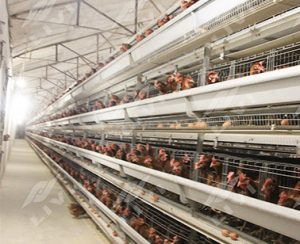In commercial egg production, battery cage system are widely used due to their high efficiency and compact design. Despite the controversy, the system is still widely used in the industry.
The battery cage system places laying hens in cages, which are designed to maximize space. This intensive farming method allows more chickens to be raised in a limited area, thereby increasing egg production. Farmers can harvest eggs more easily and efficiently. Because these battery cage system for layers are usually equipped with automatic feeding, watering and egg collection mechanisms. The proven effectiveness of battery cage system in meeting high production demands presents a significant commercial opportunity for the farming industry.
Automatic poultry equipment in battery cage system
Battery cages are often constructed of durable materials such as galvanized steel or high-quality plastic. Each tier of layer chicken cages is skillfully fixed in the small space provided by these facilities to ensure that the chickens will not move randomly and create a stable breeding environment.
Wire mesh floors are often used on the bottom of battery chicken cages. This design is convenient for garbage disposal, and the feces can be discharged smoothly to keep the eggs clean.
The poultry feeding system is another highlight of the battery chicken cage. The automatic feeding system ensures that each cage gets the food it needs from the external feed trough immediately, maintaining a stable feed supply.
At the same time, the automatic poultry watering system is also indispensable. The cages are equipped with drinking fountains or water cups to provide a continuous source of clean drinking water for the laying hens to ensure that their water needs are met. These battery cage system for layers together facilitate the efficient operation of the battery cage system, providing an advanced solution for commercial chicken farming.

Environmentally Friendly Battery Chicken Cage System
Vertical stacking: The battery cage system for layers cleverly stacks the cages vertically into multiple layers, maximizing the use of vertical space. This layout makes it possible to accommodate more egg layers in a smaller area and therefore excels in large-scale egg production.
Aisles and walkways: Battery cage systems focus on farm worker convenience. Aisles and walkways that separate cage rows make daily tasks such as cleaning, egg collection and feeding easy. This smart design makes moving and maintenance tasks more efficient and convenient.
Feces collection system: In order to keep the environment tidy, the battery cage system is designed with a feces collection system. Manure and waste are collected centrally on trays or conveyor belts and run across the wire mesh floor for disposal or recycling as fertilizer.
Ventilation: Good ventilation is key to maintaining the health of laying hens. The battery cage system is equipped with fans and vents to ensure sufficient air circulation and reasonable temperature control to create a comfortable growth environment for laying hens.
Price estimation for battery cage system for layers
The cost of setting up a battery cage system for layers can vary based on a number of factors. Such as operating size, cage quality and additional features. The following are rough estimates for a medium-sized layer farm with 10,000 birds:
Cage Unit: The cage itself can cost anywhere from $100 to $150 per unit, depending on materials and design. For a farm of 10,000 birds, you’d probably need about 80 units. So the cost would be about $8,000 to $12,000.
Infrastructure and Housing: Building a structure to house the cages and provide basics like water and electricity can add another $12,000 to $20,000 to the total investment.
Feed: Expect to spend about $10,000 to $15,000 on nutritious feed.
Miscellaneous Charges. Including insulation, egg belts, and other accessories, total miscellaneous charges are approximately $2,000 to $3,000.
Keep in mind that these are rough estimates only, and layer cage prices can vary widely depending on location, cage quality, and prevailing market conditions. Additionally, ongoing expenses such as veterinary care and labor costs should be factored into the budget.
If you are interested in poultry farming, please leave a message to contact us!
